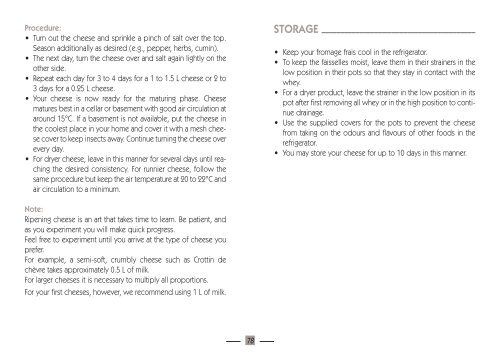Create successful ePaper yourself
Turn your PDF publications into a flip-book with our unique Google optimized e-Paper software.
LA FROMAGERE:LAGRANGE 22/07/09 15:41 Page 80<br />
Procedure:<br />
• Turn out the cheese and sprinkle a pinch of salt over the top.<br />
Season additionally as desired (e.g., pepper, herbs, cumin).<br />
• The next day, turn the cheese over and salt again lightly on the<br />
other side.<br />
• Repeat each day for 3 to 4 days for a 1 to 1.5 L cheese or 2 to<br />
3 days for a 0.25 L cheese.<br />
• Your cheese is now ready for the maturing phase. Cheese<br />
matures best in a cellar or basement with good air circulation at<br />
around 15°C. If a basement is not available, put the cheese in<br />
the coolest place in your home and cover it with a mesh cheese<br />
cover to keep insects away. Continue turning the cheese over<br />
every day.<br />
• For dryer cheese, leave in this manner for several days until reaching<br />
the desired consistency. For runnier cheese, follow the<br />
same procedure but keep the air temperature at 20 to 22°C and<br />
air circulation to a minimum.<br />
Note:<br />
Ripening cheese is an art that takes time to learn. Be patient, and<br />
as you experiment you will make quick progress.<br />
Feel free to experiment until you arrive at the type of cheese you<br />
prefer.<br />
For example, a semi-soft, crumbly cheese such as Crottin de<br />
chèvre takes approximately 0.5 L of milk.<br />
For larger cheeses it is necessary to multiply all proportions.<br />
For your first cheeses, however, we recommend using 1 L of milk.<br />
78<br />
STORAGE ________________________________________<br />
• Keep your fromage frais cool in the refrigerator.<br />
• To keep the faisselles moist, leave them in their strainers in the<br />
low position in their pots so that they stay in contact with the<br />
whey.<br />
• For a dryer product, leave the strainer in the low position in its<br />
pot after first removing all whey or in the high position to continue<br />
drainage.<br />
• Use the supplied covers for the pots to prevent the cheese<br />
from taking on the odours and flavours of other foods in the<br />
refrigerator.<br />
• You may store your cheese for up to 10 days in this manner.









